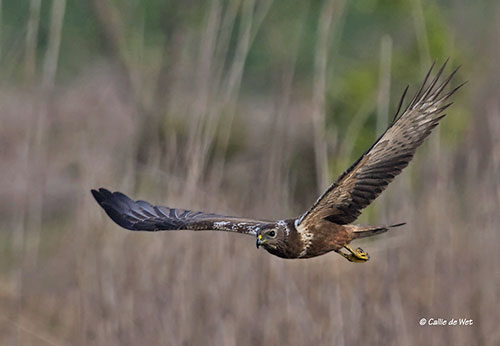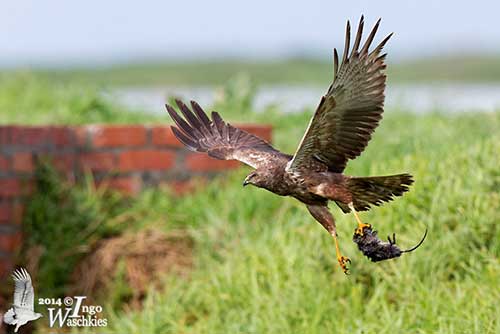
Fr: Busard grenouillard
Ang: African Marsh-Harrier
All: Froschweihe
Esp: Aguilucho Lagunero Etiópico
Ita: Albanella africana
Nd: Afrikasivhauk
Sd: grodkärrhök
Photographers:
Callie de Wet
GALLERY
Ingo Waschkies
Bird Photography
Text by Nicole Bouglouan
Sources:
HANDBOOK OF THE BIRDS OF THE WORLD Vol 2 by Josep del Hoyo-Andrew Elliot-Jordi Sargatal - Lynx Edicions - ISBN: 8487334156
BIRDS OF PREY OF AFRICA AND ITS ISLANDS by Alan and Meg Kemp - Struik Publishers - ISBN: 1770073698
BIRDS OF AFRICA SOUTH OF THE SAHARA by Ian Sinclair and Peter Ryan - Princeton University Press Princeton and Oxford - ISBN: 0691118159
BIRDS OF EAST AFRICA vol 1 by C.A.W. Guggisberg – Mount Kenya Sundries Ltd. – ISBN: 9966889051
Birds to watch in Namibia - African Marsh-Harrier
Biodiversity Explorer – The Web of Life in Southern Africa
Wikipedia, the free encyclopaedia
THE AVIANWEB - Beauty of Birds (Sibylle Faye)
African Marsh-Harrier
Circus ranivorus
Accipitriformes Order – Accipitridae Family
INTRODUCTION:
The African Marsh-Harrier is a heavy built harrier usually associated with wetlands. It is mainly resident in suitable moist habitats, but it is patchily distributed across eastern, central and southern Africa. Some declines are reported due to degradation of wetlands.
It typically feeds on small vertebrates caught on the ground, and large insects caught in flight.
This monogamous raptor remains on its breeding territory almost all year round. It nests in reedbeds as solitary pairs, and roosts alone at night, unlike other harrier species that roost in groups.
Although being threatened by destruction of wetlands, the African Marsh-Harrier is known to adapt to new wetlands created by dams and sewage-works. The species is not currently globally threatened.
DESCRIPTION OF THE BIRD:
Biometrics:
Length: 44-49 cm
Wingspan: 105-125 cm
Weight: 382-590 g
The African Marsh-Harrier adult has dark-grey-brown plumage overall. On the upperparts, the feathers are edged and streaked rufous, and the wing-coverts are barred with white. Unlike other harriers, the present species has dark brown rump (not white).
Head, neck and underparts are heavily edged and streaked with buff, cream and white. But lower breast, thighs and vent are uniformly rufous. On the underwing, the wing-coverts are buff and heavily streaked dark brown.
Flight feathers and tail are barred at all ages. They are sooty-brown above and mostly grey-brown below, with paler, well-spaced bars.
The bill is black with yellow cere. The eyes are yellow. The bare legs and feet are yellow with black talons.
Male and female are fairly similar, although the female is browner and larger, whereas the male has greyer flight-feathers and uppertail.
The juvenile is dark grey-brown overall, with buff tips to shoulders and upperwing coverts. We can see a broad, creamy-white breast band, and some black and rufous streaks on the breast. On the wings, the leading edge is creamy-white. The rump is rufous and the tail is barred with dark brown and rufous. The underparts are plain with chestnut on flanks and belly. On the head, crown and rim of ear-coverts are streaked with buff.
The eyes are red-brown. Cere, legs and feet are pale yellow.

RANGE:
The African Marsh-Harrier is found in DRCongo (mainly in E), South Sudan, Uganda and Kenya, S to S South Africa. There are some records in NE Africa, to Ethiopia and Somalia.
HABITAT:
The African Marsh-Harrier frequents a variety of moist areas such as marshes, reedbeds, seasonal swamps and adjacent grassland and cultivated areas where it hunts and forages.
The species is visible from sea-level up to 3,000 metres of elevation. In E Africa, it is usually seen above 1,500 metres, and exceptionally up to 4,000 metres in Ethiopia.
CALLS AND SONGS: SOUNDS BY XENO-CANTO
The African Marsh-Harrier is mainly silent, but during the breeding season, and especially during courtship displays, both adults produce some sounds.
Around the nest, soft calls can be heard. During the food pass, the male gives a “pew” call and the female responds with a plaintive “jeeee-uk”. During the aerial displays, we can hear a high-pitched “fee-ooo” and a squealing “oweeep”. They also produce a loud, chattering “kyak-kyak-kyak”. The alarmed birds utter various soft, chuckling notes.
BEHAVIOUR IN THE WILD:
The African Marsh-Harrier feeds on small vertebrates, mainly rodents and birds, often ducks of genus Anas up to 600 grams. It takes the chicks at heron colonies, but also eggs, frogs, insects, and sometimes carrion, reptiles and fish.
Rodents and birds are taken after sharp twist to the ground, and occasionally after a short aerial chase. It often hunts on very windy days, rapidly diving to the ground to ambush its prey. It is often seen flying low over reeds along the water’s edge, less often over grassland and cropland.

The African Marsh-Harrier is monogamous with long-term pair-bonds. It performs aerial displays accompanied by loud calls. It often soars high in the sky, and performs floppy aerial dances including spiraling flight and horizontal sky-dancing displays. It also makes backwards loops and exaggerated undulating flight.
It is solitary nester, with the nests placed 1-3 kilometres apart in large wetlands. It also roosts solitary, on the ground or on platform above the marsh.
The African Marsh-Harrier is usually mainly resident, especially around permanent waterbodies. The species is nomadic around seasonal wetlands. The juveniles perform extensive movements to isolated waterbodies, far from their usual range.
The African Marsh-Harrier has typical floating, buoyant flight with wings held in shallow V-shape, and mainly while gliding. It soars with extended wings and usually closed tail.
REPRODUCTION OF THIS SPECIES:
The African Marsh-Harrier is highly territorial during this period, and intense territorial disputes involve two birds locking their talons while flying and spiraling to the ground. The egg laying season is year-round, with peak between June and November, mainly in dry season.
Both adults build the nest, a shallow platform of sticks with a second platform above, made with grass and reed stems. It is placed in reeds, near or over the water, usually in large wetland. The nest may also be built in low bushy tree above water, or in sedges or field close to the wetland. The same nesting site is often reused by the same pair in several following years.
The female lays 2-5 bluish-white eggs, and incubates alone during 31-33 days. The male feeds her at nest. At hatching the chicks have buffy down first, but the second coat is white. The female broods them and feeds them with the food brought by the male. When the chicks are 18-20 days old, both adults hunt together. The young are able to defend themselves by lying on their backs and kicking. They leave the nest 38-45 days after hatching, and become independent 29-45 days later.
PROTECTION / THREATS / STATUS:
The African Marsh-Harrier is threatened by drainage, burning and grazing of wetlands, although the species is able to adapt to new wetlands created by artificial waterbodies. In addition, this raptor is slightly contaminated by pesticides.
The population is preliminary estimated to number 10,000/100,000 individuals, with 3,000/3,600 pairs in South Africa. But the population is suspected to decline. However, the species is still locally common in some countries such as Zambia.
The African Marsh-Harrier is currently evaluated as Least Concern.